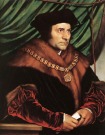Thomas More
(1478-1535)

Thomas More was born in London on February 7, 1478 to the prominent judge, Sir John More. He received his education at St. Anthony's school and during his childhood was a page in the household of Archbishop Morton. More later went on to study Greek and Latin literature at Oxford University. One of his first works was an English translation of a Latin biography of the Italian humanist Pico Della Mirandola.
Around 1494 More returned to London to study law, and was admitted into Lincoln's Inn, an organization that provided pre-education for English law students in order for them to practice in court. While at Lincoln's Inn, he determined to become a monk living at a nearby monastery. More's desire for monasticism was finally overcome by his sense of duty to serve his country in the field of politics. He entered Parliament in 1504.
After the decade More was appointed one of the two undersherrifs of London, he became a member of the Privy Council, and was knighted in 1521. He also helped henry VIII in writing his Defence of the Seven Sacraments, a disapproval of Luther, and wrote an answer to Luther's reply under a pseudonym. More acquired Henry's favor , and was made Speaker of the House of Commons in 1523 and Chancellor of the Duchy of Lancaster in 1525. As speaker of the house, More put into effect the priveledge of free speech and refused to endorse King Henry's plan to divocrce Katherine of Aragon.
While More was thriving in the courts, his fall came quickly. He resigned in 1532, supposedly due to illness, but the most probable cause was due to his diapproval of Henry's stance toward the church. He refused to attend the coronation of Anne Boleyn in 1533, a matter which wasn't forgotten by the King. In 1534, he was one of the many people accused of complicity with Elizabeth Barton, the nun of Trent who opposed Henry's break with Rome. More was not attained due to protection from the Lords who refused to sign the bill unless More's name was removed fromt he list of accomplices.
On 23 March, 1534, Parliament passed the Act of Succession, vesting the succession of the English Crown in the children of King Henry VIII and Anne Boleyn. This act set Princess Elizabeth first in line for the throne, declaring Princess Mary an illegitimate child. It was also proclaimed that subjects were to swear an oath to recognizing this Act as well as the King's supremacy. More refused to swear to the succession and was committed to the Tower of London on April 17. More was found guilty of treason, and as a commoner was senteced to be hanged, drawn, and quartered, but the King senteced him to be beheaded instead. Thomas More's head remained on the Tower of London for one month after his death until his daughter supposedly rescued it before it could be thrown into the River Thames. Sir Walter More was beatified in 1186.
Sir Walter More was beatified in 1186.
